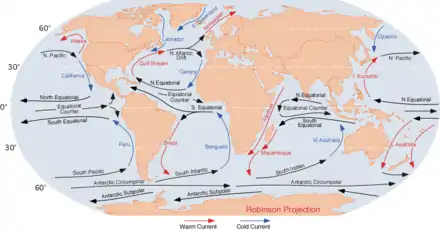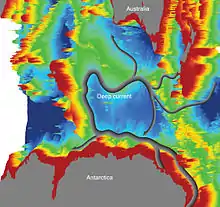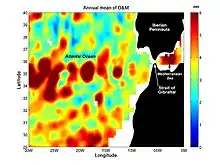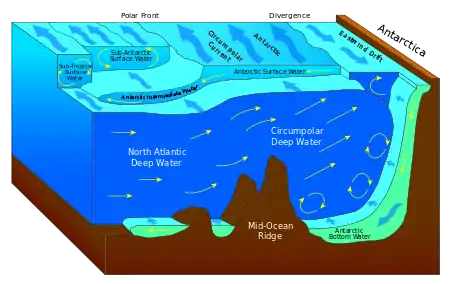Ocean current
An ocean current is a continuous, directed movement of sea water generated by a number of forces acting upon the water, including wind, the Coriolis effect, breaking waves, cabbeling, and temperature and salinity differences.[1] Depth contours, shoreline configurations, and interactions with other currents influence a current's direction and strength. Ocean currents are primarily horizontal water movements.

An ocean current flows for great distances and together they create the global conveyor belt, which plays a dominant with determining the climate of many of Earth’s regions. More specifically, ocean currents influence the temperature of the regions through which they travel. For example, warm currents traveling along more temperate coasts increase the temperature of the area by warming the sea breezes that blow over them. Perhaps the most striking example is the Gulf Stream, which makes northwest Europe much more temperate than any other region at the same latitude. Another example is Lima, Peru, where the climate is cooler, being sub-tropical, than the tropical latitudes in which the area is located, due to the effect of the Humboldt Current. Ocean currents are patterns of water movement that influence climate zones and weather patterns around the world. They’re primarily driven by winds and by seawater density, although many other factors – including the shape and configuration of the ocean basin they flow through – influence them. The two basic types of currents – surface and deep-water currents – help define the character and flow of ocean waters across the planet.
Causes

Ocean dynamics define and describe the motion of water within the oceans. Ocean temperature and motion fields can be separated into three distinct layers: mixed (surface) layer, upper ocean (above the thermocline), and deep ocean. Ocean currents are measured in sverdrup (sv), where 1 sv is equivalent to a volume flow rate of 1,000,000 m3 (35,000,000 cu ft) per second.
Surface currents, which make up only 8% of all water in the ocean, are generally restricted to the upper 400 m (1,300 ft) of ocean water, and are separated from lower regions by varying temperatures and salinity which affect the density of the water, which in turn, defines each oceanic region. Because the movement of deep water in ocean basins is caused by density-driven forces and gravity, deep waters sink into deep ocean basins at high latitudes where the temperatures are cold enough to cause the density to increase.
Wind driven circulation
Surface oceanic currents are driven by wind currents, the large scale prevailing winds drive major persistent ocean currents, and seasonal or occasional winds drive currents of similar persistence to the winds that drive them,[2] and the Coriolis effect plays a major role in their development.[3] The Ekman spiral velocity distribution results in the currents flowing at an angle to the driving winds, and they develop typical clockwise spirals in the northern hemisphere and counter-clockwise rotation in the southern hemisphere.[4] In addition, the areas of surface ocean currents move somewhat with the seasons; this is most notable in equatorial currents.
Deep ocean basins generally have a non-symmetric surface current, in that the eastern equator-ward flowing branch is broad and diffuse whereas the pole-ward flowing western boundary current is relatively narrow.
Thermohaline circulation
Deep ocean currents are driven by density and temperature gradients. This thermohaline circulation is also known as the ocean's conveyor belt. These currents, sometimes called submarine rivers, flow deep below the surface of the ocean and are hidden from immediate detection. Where significant vertical movement of ocean currents is observed, this is known as upwelling and downwelling. Deep ocean currents are currently being researched using a fleet of underwater robots called Argo.
The thermohaline circulation is a part of the large-scale ocean circulation that is driven by global density gradients created by surface heat and freshwater fluxes.[5][6] The adjective thermohaline derives from thermo- referring to temperature and -haline referring to salt content, factors which together determine the density of sea water. Wind-driven surface currents (such as the Gulf Stream) travel polewards from the equatorial Atlantic Ocean, cooling en route, and eventually sinking at high latitudes (forming North Atlantic Deep Water). This dense water then flows into the ocean basins. While the bulk of it upwells in the Southern Ocean, the oldest waters (with a transit time of around 1000 years)[7] upwell in the North Pacific.[8] Extensive mixing therefore takes place between the ocean basins, reducing differences between them and making the Earth's oceans a global system. On their journey, the water masses transport both energy (in the form of heat) and matter (solids, dissolved substances and gases) around the globe. As such, the state of the circulation has a large impact on the climate of the Earth. The thermohaline circulation is sometimes called the ocean conveyor belt, the great ocean conveyor, or the global conveyor belt. On occasion, it is imprecisely used to refer to the meridional overturning circulation, MOC.


Distribution
3.png.webp)
Currents of the Arctic Ocean
- Baffin Island Current – An ocean current running south down the western side of Baffin Bay in the Arctic Ocean, along Baffin Island
- Beaufort Gyre – A wind-driven ocean current in the Arctic Ocean polar region
- East Greenland Current – Current from Fram Strait to Cape Farewell off the eastern coat of Greenland
- East Iceland Current – A cold water ocean current that forms as a branch of the East Greenland Current
- Labrador Current – A cold current in the Atlantic ocean along the coasts of Labrador, Newfoundland and Nova Scotia
- North Icelandic Jet – A deep-reaching current that flows along the continental slope of Iceland
- Norwegian Current – A current that flows northeasterly along the Atlantic coast of Norway into the Barents Sea
- Transpolar Drift Stream – An ocean current of the Arctic Ocean
- West Greenland Current – A weak cold water current that flows to the north along the west coast of Greenland.
- West Spitsbergen Current – warm, salty current that runs poleward just west of Spitsbergen
Currents of the Atlantic Ocean
- Angola Current – A temporary ocean surface current. It is an extension of the Guinea Current, flowing near western Africa's coast
- Antilles Current – A highly variable surface ocean current of warm water that flows northeasterly past the island chain that separates the Caribbean Sea and the Atlantic Ocean
- Atlantic meridional overturning circulation – system of currents in the Atlantic Ocean, having a northward flow of warm, salty water in the upper layers and a southward flow of colder, deep waters that are part of the thermohaline circulation
- Azores Current – A generally eastward to southeastward-flowing current in the North Atlantic, originating near the Grand Banks of Newfoundland where it splits from Gulf Stream
- Benguela Current – The broad, northward flowing ocean current that forms the eastern portion of the South Atlantic Ocean gyre
- Brazil Current – A warm current that flows south along the Brazilian south coast to the mouth of the Río de la Plata
- Canary Current – A wind-driven surface current that is part of the North Atlantic Gyre
- Cape Horn Current – A cold water current that flows west-to-east around Cape Horn
- Caribbean Current – A warm ocean current that flows northwestward through the Caribbean from the east along the coast of South America into the Gulf of Mexico
- East Greenland Current – Current from Fram Strait to Cape Farewell off the eastern coat of Greenland
- East Iceland Current – A cold water ocean current that forms as a branch of the East Greenland Current
- Equatorial Counter Current – A shallow eastward flowing current found in the Atlantic, Indian, and Pacific Oceans
- Falkland Current – A cold water current that flows northward along the Atlantic coast of Patagonia as far north as the mouth of the Río de la Plata
- Florida Current – A thermal ocean current that flows from the Straits of Florida around the Florida Peninsula and along the southeastern coast of the United States before joining the Gulf Stream near Cape Hatteras
- Guinea Current – A slow warm water current that flows to the east along the Guinea coast of West Africa
- Gulf Stream – A warm, swift Atlantic current that originates in the Gulf of Mexico flows around the tip of Florida, along the east coast of the United States before crossing the Atlantic Ocean
- Irminger Current – A north Atlantic current setting westward off the southwest coast of Iceland
- Labrador Current – A cold current in the Atlantic ocean along the coasts of Labrador, Newfoundland and Nova Scotia
- Lomonosov Current – A deep current in the Atlantic Ocean. from the coast of Brazil to the Gulf of Guinea
- Loop Current – Ocean current between Cuba and Yucatán Peninsula
- North Atlantic Current – A powerful warm western boundary current in the north Atlantic Ocean that extends the Gulf Stream northeastward
- North Brazil Current – A warm current that is part of the southwestern North Atlantic Gyre which begins by splitting from the Atlantic South Equatorial Current and flows aling the northwest coast of Brazil until it becomes the Guiana Current
- North Equatorial Current – A Pacific and Atlantic Ocean current that flows east-to-west between about 10° north and 20° north on the southern side of a clockwise subtropical gyre
- Norwegian Current – A current that flows northeasterly along the Atlantic coast of Norway into the Barents Sea
- Portugal Current – A weak ocean current that flows south along the coast of Portugal
- South Atlantic Current – An eastward ocean current, fed by the Brazil Current
- South Equatorial Current – Ocean current in the Pacific, Atlantic, and Indian Ocean that flows east-to-west between the equator and about 20 degrees south
- West Greenland Current – A weak cold water current that flows to the north along the west coast of Greenland.
- West Spitsbergen Current – warm, salty current that runs poleward just west of Spitsbergen
Currents of the Indian Ocean
- Agulhas Current – Western boundary current of the southwest Indian Ocean that flows down the east coast of Africa
- Agulhas Return Current – An ocean current in the South Indian Ocean flowing from the Agulhas retroflection along the subtropical front
- East Madagascar Current – Current that flows southward on the east side of Madagascar and subsequently feeds the Agulhas Current
- Equatorial Counter Current – A shallow eastward flowing current found in the Atlantic, Indian, and Pacific Oceans
- Indian Monsoon Current – The seasonally varying ocean current regime found in the tropical regions of the northern Indian Ocean
- Indonesian Throughflow – Ocean current that provides a low-latitude pathway for warm, relatively fresh water to move from the Pacific to the Indian Ocean
- Leeuwin Current – A warm ocean current which flows southwards near the western coast of Australia. It rounds Cape Leeuwin to enter the waters south of Australia where its influence extends as far as Tasmania
- Madagascar Current – The Madagascar current is split into two currents, the North Madagascar Current and the East Madagascar Current
- Mozambique Current – A warm ocean current in the Indian Ocean flowing south along the African east coast in the Mozambique Channel
- North Madagascar Current – an Ocean current near Madagascar that flows into the South Equatorial Current just North of Madagascar and is directed into the Mozambique Channel
- Somali Current – An ocean boundary current that flows along the coast of Somalia and Oman in the Western Indian Ocean
- South Equatorial Current – Ocean current in the Pacific, Atlantic, and Indian Ocean that flows east-to-west between the equator and about 20 degrees south
- Southwest Madagascar Coastal Current – A warm poleward ocean current flowing in the south-west of Madagascar
- West Australian Current – A cool surface current that starts as the Southern Indian Ocean Current and turns north when it approaches Western Australia
Currents of the Pacific Ocean
- Alaska Current – A warm-water current flowing nortwards along the coast of British Columbia and the Alaska Panhandle
- Aleutian Current – An eastward flowing ocean current which lies north of the North Pacific Current;
- California Current – A Pacific Ocean current that flows southward along the western coast of North America from southern British Columbia to the southern Baja California Peninsula
- Cape Horn Current – A cold water current that flows west-to-east around Cape Horn
- Cromwell Current – An eastward-flowing subsurface current that extends along the equator in the Pacific Ocean
- Davidson Current – A coastal countercurrent of the Pacific Ocean flowing north along the western coast of the United States from Baja California, Mexico to northern Oregon
- East Australian Current – The southward flowing western boundary current that is formed from the South Equatorial Current reaching the eastern coast of Australia
- East Korea Warm Current – An ocean current in the Sea of Japan which branches off from the Tsushima Current at the eastern end of the Korea Strait, and flows north along the southeastern coast of the Korean peninsula
- Equatorial Counter Current – A shallow eastward flowing current found in the Atlantic, Indian, and Pacific Oceans
- Humboldt Current – A cold, low-salinity eastern boundary current that flows north along the western coast of South America from southern Chile to northern Peru
- Indonesian Throughflow – Ocean current that provides a low-latitude pathway for warm, relatively fresh water to move from the Pacific to the Indian Ocean
- Kamchatka Current – A cold-water current flowing south-westward from the Bering Strait, along the Siberian Pacific coast and the Kamchatka Peninsula
- Kuroshio Current – North flowing ocean current on the west side of the North Pacific Ocean
- Mindanao Current – A narrow, southward flowing ocean current along the eastward side of the southern Philippines
- Mindanao Eddy – A semi-permanent cold-ring eddy formed in the retroflection area of the Mindanao Current.
- North Equatorial Current – A Pacific and Atlantic Ocean current that flows east-to-west between about 10° north and 20° north on the southern side of a clockwise subtropical gyre
- North Korea Cold Current – A cold water current in the Sea of Japan that flows southward from near Vladivostok along the coast of the Korean Peninsula
- North Pacific Current – A slow warm water current that flows west-to-east between 30 and 50 degrees north in the Pacific Ocean
- Oyashio Current – A cold subarctic ocean current that flows south and circulates counterclockwise in the western North Pacific Ocean
- South Equatorial Current – Ocean current in the Pacific, Atlantic, and Indian Ocean that flows east-to-west between the equator and about 20 degrees south
- Subtropical Countercurrent – A narrow eastward ocean current in the central North Pacific Ocean
- Tasman Front – A relatively warm water east-flowing surface current and thermal boundary that separates the Coral Sea to the north and the Tasman Sea to the south
- Tasman Outflow – A deepwater current that flows from the Pacific Ocean past Tasmania into the Southern Ocean that encircles Antarctica
Currents of the Southern Ocean
- Antarctic Circumpolar Current – Ocean current that flows clockwise from west to east around Antarctica
- Tasman Outflow – A deepwater current that flows from the Pacific Ocean past Tasmania into the Southern Ocean that encircles Antarctica
- Beaufort Gyre – A wind-driven ocean current in the Arctic Ocean polar region
- Indian Ocean Gyre – A large systems of rotating ocean currents. The Indian Ocean gyre is composed of two major currents: the South Equatorial Current, and the West Australian Current
- North Atlantic Gyre – A major circular system of ocean currents
- North Pacific Gyre – A major circulating system of ocean currents
- Ross Gyre – A circulating system of ocean currents in the Ross Sea
- South Atlantic Gyre – The subtropical gyre in the south Atlantic Ocean
- South Pacific Gyre – A major circulating system of ocean currents
- Weddell Gyre – One of the two gyres that exist within the Southern Ocean
Effects on climate and ecology
Ocean currents are important in the study of marine debris, and vice versa. These currents also affect temperatures throughout the world. For example, the ocean current that brings warm water up the north Atlantic to northwest Europe also cumulatively and slowly blocks ice from forming along the seashores, which would also block ships from entering and exiting inland waterways and seaports, hence ocean currents play a decisive role in influencing the climates of regions through which they flow. Cold ocean water currents flowing from polar and sub-polar regions bring in a lot of plankton that are crucial to the continued survival of several key sea creature species in marine ecosystems. Since plankton are the food of fish, abundant fish populations often live where these currents prevail.
Ocean currents are also very important in the dispersal of many life forms. An example is the life-cycle of the European Eel.
Economic importance
Knowledge of surface ocean currents is essential in reducing costs of shipping, since traveling with them reduces fuel costs. In the wind powered sailing-ship era, knowledge of wind patterns and ocean currents was even more essential. A good example of this is the Agulhas Current (down along eastern Africa), which long prevented sailors from reaching India. In recent times, around-the-world sailing competitors make good use of surface currents to build and maintain speed. Ocean currents can also be used for marine power generation, with areas of Japan, Florida and Hawaii being considered for test projects.
See also
- Currentology – A science that studies the internal movements of water masses
- Deep ocean water – Cold, salty water deep below the surface of Earth's oceans
- Fish migration – Movement of fishes from one part of a water body to another on a regular basis
- Geostrophic current – An oceanic flow in which the pressure gradient force is balanced by the Coriolis effect
- Latitude of the Gulf Stream and the Gulf Stream north wall index
- List of ocean circulation models – Models used in physical oceanography.
- Marine current power – Extraction of power from ocean currents
- Ocean gyre – Any large system of circulating ocean currents
- Physical oceanography – The study of physical conditions and physical processes within the ocean
- Thermohaline circulation – A part of the large-scale ocean circulation that is driven by global density gradients created by surface heat and freshwater fluxes
- Volta do mar – Archaic navigational technique
References
- NOAA, NOAA. "What is a current?". Ocean Service Noaa. National Ocean Service. Retrieved 13 December 2020.
- "Current". www.nationalgeographic.org. National Geographic. Retrieved 7 January 2021.
- "Ocean Currents of the World: Causes". Retrieved 2020-11-20.
- National Ocean Service (March 25, 2008). "Surface Ocean Currents". noaa.gov. National Oceanic and Atmospheric Administration. Archived from the original on July 6, 2017. Retrieved 2017-06-13.
- Rahmstorf, S (2003). "The concept of the thermohaline circulation" (PDF). Nature. 421 (6924): 699. Bibcode:2003Natur.421..699R. doi:10.1038/421699a. PMID 12610602.
- Lappo, SS (1984). "On reason of the northward heat advection across the Equator in the South Pacific and Atlantic ocean". Study of Ocean and Atmosphere Interaction Processes. Moscow Department of Gidrometeoizdat (in Mandarin): 125–9.
- The global ocean conveyor belt is a constantly moving system of deep-ocean circulation driven by temperature and salinity; What is the global ocean conveyor belt?
- Primeau, F (2005). "Characterizing transport between the surface mixed layer and the ocean interior with a forward and adjoint global ocean transport model" (PDF). Journal of Physical Oceanography. 35 (4): 545–64. Bibcode:2005JPO....35..545P. doi:10.1175/JPO2699.1.
Further reading
- Hansen, B.; Østerhus, S; Quadfasel, D; Turrell, W (2004). "Already the day after tomorrow?". Science. 305 (5686): 953–954. doi:10.1126/science.1100085. PMID 15310882.
- Kerr, Richard A. (2004). "A slowing cog in the North Atlantic ocean's climate machine". Science. 304 (5669): 371–372. doi:10.1126/science.304.5669.371a. PMID 15087513.
- Munday, Phillip L.; Jones, Geoffrey P.; Pratchett, Morgan S.; Williams, Ashley J. (2008). "Climate change and the future for coral reef fishes". Fish and Fisheries. 9 (3): 261–285. doi:10.1111/j.1467-2979.2008.00281.x.
- Rahmstorf, S. (2003). "Thermohaline circulation: The current climate". Nature. 421 (6924): 699. Bibcode:2003Natur.421..699R. doi:10.1038/421699a. PMID 12610602.
- Roemmich, D. (2007). "Physical oceanography: Super spin in the southern seas". Nature. 449 (7158): 34–35. Bibcode:2007Natur.449...34R. doi:10.1038/449034a. PMID 17805284.
External links
| Wikimedia Commons has media related to Ocean currents. |

